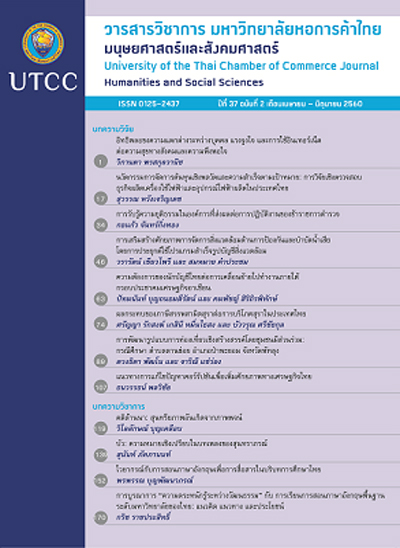Foreign Currency Exposure and Performance: An Empirical Study in the Stock Exchange of Thailand
Main Article Content
Abstract
This research examines foreign currency exposure as well as whether foreign currency exposure is associated with foreign sales, liquidity levels, profitability, leverage, and firm size using public companies listed on the Stock Exchange of Thailand between 2012 and 2014. This study measures foreign currency exposure as the sensitivity of stock returns to exchange rate volatility. The findings indicate that foreign currency exposure is positively related to foreign sales, liquidity levels, profitability and leverage, while it is negatively related to firm size. The results are consistent with our expectation and the findings from prior research in other countries. When each industry sector is analyzed separately, its differential association with variables of interest are documented.
Article Details
ลิขสิทธิ์ของบทความ
ผลงานที่ได้รับการตีพิมพ์ถือเป็นลิขสิทธิ์ของมหาวิทยาลัยหอการค้าไทย ห้ามมิให้นำเนื้อหา ทัศนะ หรือข้อคิดเห็นใด ๆ ของผลงานไปทำซ้ำ ดัดแปลง หรือเผยแพร่ ไม่ว่าทั้งหมดหรือบางส่วนโดยไม่ได้รับอนุญาตเป็นลายลักษณ์อักษรจากมหาวิทยาลัยหอการค้าไทยก่อน
References
Ahmed, H., Azevedo, A., & Guney, Y. (2014). The effect of hedging of firm value and performance: Evidence from the nonfinancial UK Firms. European Financial Management Association (EFMA) 2014 conference paper. Rome, Italy: EFMA.
Allayannis, G., & Ofek, E. (2001). Exchange rate exposure, hedging, and the use of foreign currency derivatives. Journal of International Money and Finance, 20, 273-296.
Allayannis, G., & Weston, J. P. (2001). The use of foreign currency derivatives and firm market value. The Review of Financial Studies, 14(1), 243-276.
Allayannis, G., Lel, U., & Miller, D.P. (2012). The use of foreign currency derivatives, corporate governance, and firm value around the world. International Economics, 87, 65-79.
Bank of Thailand. (2015). Foreign exchange rate. Retrieved August 20, 2015, from https://www.bot.or.th/Thai/Statistics/FinancialMarkets/ExchangeRate/Pages/ExchangeRate.aspx (in Thai).
Bellone, F., Musso, P., Nesta, L., & Schiavo, S. (2010). Financial constraints and firm export behavior. The World Economy, 33(3), 347-373.
Bodnar, G. M., & Wong, M. H. F. (2003). Estimating exchange rate exposure issues in model structure. Financial Management, 32(1), 35-67.
Choi, J. J., & Prasad, A. M. (1995). Exchange risk sensitivity and its determinants: A firm and industry analysis of U.S. multinationals. Financial Management, 24(3), 77-88.
Chow, E.H., & Chen, H.L. (1998). The determinants of foreign exchange rate exposure: Evidence on Japanese. Pacific-Basin Finance Journal, 6, 153-174.
Clarke, E., & Mefteh, S. (2010). Foreign currency derivatives use, firm value and the effect of the exposure profile: Evidence from France. International Journal of Business, 15(2), 183-196.
Dekle, R., & Ryoo, H. H. (2007). Exchange rate fluctuations, financing constraints, hedging, and exports: Evidence from firm level data. Journal of International Financial Markets, Institutions & Money, 17, 437-451.
Dominguez, K. M. E., & Tesar, L. L. (2001). A re-examination of exchange rate exposure. American Economic Review, 91(2), 369-399.
Dominguez, K. M. E., & Tesar, L. L. (2006). Exchange rate exposure. Journal of international Economics, 68, 188-218.
Guillou, S., & Schiavo, S. (2014). Exchange rate exposure under liquidity constraints. Industrial and Corporate Change, 23(6), 1541-1561.
He, J., & Ng, L.K. (1998). The foreign exchange exposure of Japanese multinational corporations. The Journal of Finance, 53(2), 733-753.
He, J., Ng, L.K., & Wu, X. (1997). Foreign exchange exposure, risk and the Japanese stock market. Hong Kong: University of Hong Kong.
Hunter, D.M. (2005). Time-varying exchange rate exposure of small and large firms. Tampa, FL: University of South Florida.
Ito, T., Koibuchi, S., Sato., K., & Shimizu, J. (2013). Exchange rate exposure and exchange rate risk management: The case of Japanese exporting firms. RIETI Discussion Paper Series, 13(25), 1-22.
Jorion, P. (1990). The exchange-rate exposure of U.S. multinationals. The Journal of Business, 63, 331-345.
Kim, J. H., & Kim, J. (2015). Financial regulation, exchange rate exposure, and hedging activities: Evidence from Korean firms. Emerging Markets Finance & Trade, 51, 152-173.
Kothari, S. P., & Hentschel, L. (2001). Are corporations reducing of taking risks with derivatives? Journal of Financial and Quantitative Analysis, 36(1), 93-118.
Lan, L. H., Chen, C.C., & Chuang, S.S. (2015). Exchange rate risk management: What can we learn from financial crises? Economic Modelling, 45, 187-192.
Magee, S. (2013). The effect of foreign currency hedging on the probability of financial distress. Accounting and Finance, 53, 1107-1127.
Poopat, C. (2007). Fundamental analysis strategy and predictability in the cross-section of Thai stock returns (Unpublished master independent study). Thammasat University, Bangkok, Thailand.
Pramborg, B. (2004). Derivatives hedging, geographical diversification, and firm market value. Journal of Multinational Financial Management, 14, 117-133.
Ritdumrongkul, A. (2011). Derivative activities and Thai banks’ interest rate and exchange rate exposures (Unpublished master independent study). Thammasat University, Bangkok, Thailand.
Rossi, J. L., Junior, & Laham, J. (2008). The impact of hedging on firm value: Evidence from Brazil. Journal of International Finance and Economics, 8, 76-91.
Solakoglu, M. N., & Demir, N. (2009). Exchange-rate exposure and the financial factor. Journal of Economic and Social Research, 11(2), 29-42.
Vathananond, S. (2009). Foreign exchange exposure: Evidence of Thailand foods and beverages industry. The Journal of Social Science, 67, 65-83.
World Bank. (2017). Exports of goods and services. Retrieved March 8, 2018, from https://data.worldbank.org/indicator/NE.EXP.GNFS.ZS?locations=TH
Zhang, X., & Liu, X. (2012). How responsive are Chinese exports to exchange rate changes? Evidence from firm-level data. Journal of Development Studies, 48(10), 1489-1504.


